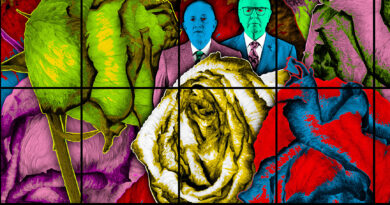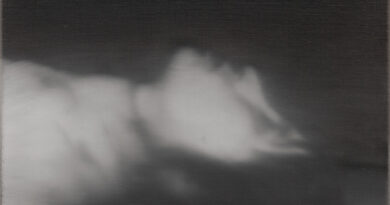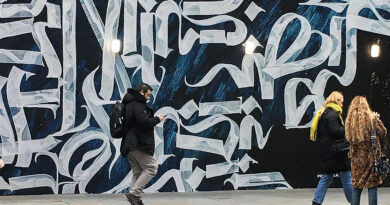a queer imagination that constrains the structure from purity
MÜMTAZ SAĞLAM
“The practice of painting is in struggle of constructing an intensive mass depending, sometimes, on the outcomes – naturally and suddenly – resulting from the nature of action of painting. This priority given to naturalness depends on the principles of superposing the limited scope of tools and seemingly limited action. Doing this by deconstruction, condensing, bending, and wrapping in, we witness this process come true in a ritual of a heterotopic concluding emerging at extreme points in a discipline sustaining vagueness.

In Gülay Yaşayanlar’s paintings, the transformation of figurative structuring into a construction of a node body that reflects consciousness and the self makes us to reconsider the perception of body that comes to the fore. This structure that is formed more like a spot integrity is not only empowered by physical or biological modification. This weird and complex structure that is diversified and formed all of a sudden is also related to update cultural and political anxieties. It is a structure that reflects a mental density and that includes itself and the states it is opposed to. It is a shelter that replaces the intimidating space which it produces through the power of criticism pushing itself towards a destructive process with an ideological evaluation.
To repeat, this image is very lonely in a bottomless identification space. This sustaining loneliness that does not accept identification seems to depend only on the mental world that constructs it. What needs to be highlighted here is the matter of multiplication of these image-structures through a hybrid body typology usually granted organless. The image-structures in a diversity that makes repetition legitimate lead the discussions on sameness to turn into a sheer border violation. It is inevitable for the attempts to create – which has to exceed its own source each time – to arrive at interpretations that include unique differences. Moreover, it is not easy at all to make it possible with the structures pushed enthusiastically into unknown and vague space tying body perception. The body continually presented to us seems to give this image a historical quality and make it natural to the degree that it provides visibility for it. On the other hand, it shows that this is possible with an image embodied remaining within the scope of painting techniques. The conditions for representation is reversed with a narration that sounds like anonymity, vagueness, and queer imagination1 byproblematizing a speculative view in the given culture of the present visual.
The practice of painting is in struggle of constructing an intensive mass depending, sometimes, on the outcomes – naturally and suddenly – resulting from the nature of action of painting. This priority given to naturalness depends on the principles of superposing the limited scope of tools and seemingly limited action. Doing this by deconstruction, condensing, bending, and wrapping in, we witness this process come true in a ritual of a heterotopic concluding emerging at extreme points in a discipline sustaining vagueness. Therefore, these exaggerated interruptions living in this principled eclipse, emphasis on un-identification or quests for using metaphors “may add to the work queer results with a good timing and an appropriate attempt”2 as indicated by Levent Şentürk in the context of architecture.
We can modify the visual accumulation diversified and multiplied/emerging at the form or image level with bio-resemblance by means of the thought of production we relate through repetition.3 It is clear that the forms emerging simultaneously within the techniques of forming, surface and texture layers have a queer stance and a quality of production and multiplication with an iconic stance at the level of typicality/sameness.
The hybrid structures themselves are outputs of disagreements. Differences in content clarify the location of pathological identity with a distance that it causes. Hence, they are of a varying and independent outlook with its structure taken for granted as it is and with its state of being kept out. It cannot find a model to which it can compare itself. There an experimental form/pattern strategy that rejects the idea of order as motivated by an innovative soul. A structure generated in this way has a vague and hybrid character we attribute to the word empty, formless having a materialistic density. This painting approach, therefore, bases the direction of general movement on the principle of contribution to ambiguity.4 This attitude forming patterns not including any functional and known elements that are composed only of transitions tell about what is vague and ambiguous about common understandings and criticize the absolute image typology in the context of space it generates. It reflects the density of consciousness functioning with the accumulation in a small, narrow space as a spatial depth. The structure embodied by completing in its own plastic process tends to diversify, abandon and become independent in its own spatial. This practice of painting overlapping with actions of accumulating, gathering, and multiplying is keen to emphasize the reality of structure diversifying and becoming queer. Particularly convolutions, layers, and forms which are condensed, hallow (made through special configuration) and seemingly transparent keep alive the tension filled with connotation, metaphors, bodies and structures. There always exist conflicts feeding the inner energy such as empty/full or transparent/dense.
On the other hand, the imaginations that become queer through this black-oblique that turns into a representation of body can be claimed to be attributed to narrations filled with mystery. Or the envision of body/trancus emerging can be said to reflect a masculine mentality refrained. However, this fiction cancelling the figurative links going beyond this integrity with its formless structure would be appropriate to be modified by an act of transition or by an expression reciprocated on more intellectual grounds. The visuality progressing with the maintenance of the queer links in a system that is abstract and becoming conceptualized interferes with the equivalences of extraordinary concepts in general perception by delving into the issue of norm particularly. Therefore, there is a realized performance regarding the rolling of an image into space through the cancellation of borders of perception based on habits. In this way, the act of forming which reverses and cancelling all the repressed perceptions with all the manipulating or weird elements of the visual language is attributed to a pathological whole kneaded with a critical but flexible and gentle response. This approach materialized through a pathological mass, spaces interfered with an envision of abnormality draw a reactive attention by developing a critical language about perceptions and issues.
The white space particularly provides a reel representation of queer relation between purity and danger. In addition to purity and cleanliness, the white space is basically a system that shows impureness and degenerate. It is not in vain to modify a relation as tense which both risks another and helps it exist and destroy it. The white space that aims for representation and queer content through degeneration harbour structures enriching with meanings such as oblique, spoilt, weird, deviant, filthy, and low. 5 In this scope it is also possible to mention a queer imagination withholding the structures in question. The conceptualization tendency we observe here and orderless reality of cases and structures obtained through experiences of expression by turning it into images is in close relation with what queer discussions reject. Through a queer reading, it is possible to find meaningful the transitivity (which can become everything when it is nothing) of imagination functioning beyond the known object/figure and system perception.
NOTES
1 Queer means “weird, strange, suspicious, sham, imbalanced, bad, and valueless”. Queer philosophy and art builds a new area of resistance by politicizing the very state of being marginalized. (see. Levent Şentürk, Kuir Mekan (queer space),Kült Publishing, İstanbul, Ocak 2015, pg.128)
2 See. Levent Şentürk, Kuir Mekan (queer space), Kült Publishing, İstanbul, Jan. 2015, pg. 24.
3 A.g.k., pg. 21.
4 A.g.k., pg. 12.
5 A.g.k., pg. 10.The practice of painting is in struggle of constructing an intensive mass depending, sometimes, on the outcomes – naturally and suddenly – resulting from the nature of action of painting. This priority given to naturalness depends on the principles of superposing the limited scope of tools and seemingly limited action. Doing this by deconstruction, condensing, bending, and wrapping in, we witness this process come true in a ritual of a heterotopic concluding emerging at extreme points in a discipline sustaining vagueness.
(Mümtaz Sağlam; Gülay Yaşayanlar / Imagination and Distance, Translation: Kenan Dikilitaş, İstanbul, 2015, sf. 66-74.)
see: https://saglamart.com/gulay-yasayanlar-conceptual-characteristics-of-creative-action



